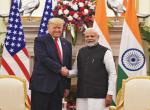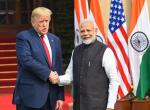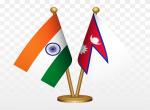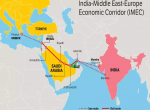Brunei Darussalam recently hosted two summits from 08 October to 10 October 2013. The first was the ASEAN summit which was held on 08 and 09 October followed by the East Asian summit on 10 October 2013. The Chinese President Xi Jinping was the most prominent dignitary present in these meetings as neither the American or Russian Presidents were present. Naturally the issue regarding South China Sea (SCS) did not generate much heat and the Sultan of Brunei noted good momentum between ASEAN countries and China over the conflicting territorial claims in the SCS. The Chinese stated their request to countries not directly involved to stay out of the dispute. Further, they emphasised that freedom of navigation in the SCS has not and never will be an issue. This was the biggest concern to nations like Australia whose 60 percent trade passes through the region. China was able to steer these conferences without any difficulty and in the absence of a strong American presence was able to push its own agenda. However, the fact remains that the issues remain unresolved and Chinese forces are creeping into this region with skill and dexterity.
In July 2010, US Secretary of State Hillary Clinton had called on the People’s Republic of China to resolve the SCS territorial dispute peacefully. China replied that the US should keep out of the issue. The US Department of Defence issued a statement on 18 August 2010 where it opposed the use of force to resolve disputes in the SCS and accused China of assertive behaviour. Issues kept simmering and in May 2011, Chinese naval ships attacked and cut the cable of a Vietnamese exploration ship. On 01July 2013, US Secretary of State John Kerry asked all nations to resolve the disputes in the SCS amicably. This was accepted by all members and China has emphasised that bilateral solutions will be found. Thereafter, in the meetings held at Brunei in October, China has endeavoured to guide the discourse on SCS that is favourable to its line of thinking with the prospects of joint exploitation of hydro carbon resources of the disputed sea bed.
Vietnam’s Cooperation with India on oil exploration in the region
India’s Oil and Natural Gas Commission Videsh Limited (OVL) has been present in Vietnam for a reasonable period. The exploration license was acquired in 1988 and commercial production began in 2003. Later in 2006, OVL acquired two more blocks in the SCS for oil exploration. These were Blocks 127 and 128. Drilling in Block 127 did not reveal any hydro carbons and OVL decided to return both these locations back to Vietnam. However, Vietnam persuaded OVL to continue drilling in Block 128 despite opposition from the Chinese explicitly stating that the area of Block 128 was within Vietnamese waters. On the insistence of Vietnam, India concluded an agreement for cooperation in hydro carbons for a period of three years in 2011.
India’s position was clarified by its Defence Minister who stated that ships of the Indian Navy would continue to go to SCS for training and our merchant ships would undertake trade. Further, India clearly stated that she supported freedom of navigation in international waters including the SCS. The agreement signed between India and Vietnam was met with stiff opposition from China who claimed that no exploration could be undertaken in areas over which China has sovereign rights. The Government of India correctly responded by stating that while China had concerns, India was going by the agreement signed with Vietnam. The Chinese claim was rejected by both India and Vietnam. As per the UN, the area of exploration belongs to Vietnam. India has firmly stated that ONGC will continue to explore oil in the SCS. Further India has clarified that the entire Indian Ocean region stretching from East African coast to SCS remains crucial to its foreign trade, energy and national security.
Vietnam has remained steadfast on the issue and in July 2012 the National Assembly of Vietnam passed a law demarcating Vietnamese sea borders to include the Paracel and Spratly Islands.
Resolution of the issues
All countries particularly US and ASEAN want the issues to be resolved peacefully. China has been dealing with the issue bilaterally without much success. Its occupation of territory by force is challenged particularly by Vietnam who has demonstrated their military capabilities and would counter use of force judiciously. The obvious question that arises is what the options for resolving the issue are. Broadly there are two options. The first is to resolve the problem through negotiations bilaterally or multilaterally. In the event of no success during negotiations, the parties could resort to other modalities of dispute settlement such as conciliation, arbitration and adjudication. This is a sovereignty dispute and it would be difficult to refer it to any form of third party without the consent of parties. Further China has exercised her right under Article 298 on UN Convention of Law of Seas to opt out of compulsory binding dispute settlement. Therefore, the case may not go before the International Tribunal for Law of Sea. The other option would be to set aside sovereignty issues and to undertake joint development of disputed areas. Joint development has produced tangible results between Malaysia and Thailand (1979-1990), Malaysia and Vietnam (1992) as also between Australia and Timor Leste (2002). This issue can be applied to Disputed Areas. However, China has yet to clarify its claims. Thereafter the aspect of Joint Development could be analysed.
Role of Vietnam
Vietnam is the only country which has physically fought the Chinese on these islands and would not bow to China over their claims. While China holds the key to resolution of problems in the South China Sea, it is pertinent to note that China resolves a border problem only after protracted negotiations so as to exploit time to its advantage. Paracel Islands was secured in 1974 by China without worthwhile opposition from Vietnam as they were involved in the war for unification. They would like to get a clearer perspective of hydrocarbon availability prior to clarifying their claims. Out of all the other claimants, Vietnam would fight for its rights and settle for a judicious resolution. The new Chinese leadership has been assertive on both the East Sea and SCS claims.
Vietnam and Japan have strongly opposed China’s aggressive behaviour on these disputes. Both these countries seek to involve the U.S. and other regional powers like India to counter China’s assertive posturing. India on her part has spoken of freedom of navigation in the high seas. Further, Vietnam has insisted that India continue offshore drilling in the blocks allotted despite Chinese opposition.
Six Wars visualised by Chinese analysts
A Hong Kong based daily Wen Wei Po published an article in June 2013 titled “Six Wars to be fought by China in the next Fifty years.” This is a Chinese Communist Party daily and the editor-in-chief is a member of the Chinese People’s Consultative Conference (CPCC). The article states that the First War would be fought for the unification of Taiwan between 2020 to 2025, the second would be re conquest of Spratly in the period 2025 to 2030, the third would be capture of Southern Tibet (Arunachal) likely to occur between 2035 to 2040, securing of Diaoyu islands between 2040 to 2045 would be the fourth war, the fifth war would be unification of Outer Mongolia between 2045 to 2050 and recapturing of lands lost to Russia would be the sixth war between 2055 and 2060. The second war would be primarily fought against Vietnam and the third war against India.
The Second War would be fought after the unification of Taiwan and it is possible that Vietnam and Philippines would put up a stiff resistance. The US is expected at best to provide outside support. In such an eventuality, the best option would be to attack the Vietnamese posted in these islands and capture them. As per the Chinese, this will compel other countries to hand over their islands to China. China possibly is underestimating the military prowess of Vietnam against whom a war was fought in 1979 to teach a lesson. Much to its anguish, China learnt a few lessons from Vietnam and over a period of time has forgotten them. The wars against Vietnam would not be a cake walk and despite the modernisation by the Chinese, the Vietnamese are focussing on Anti Access / Area Denial capability. Similarly, the capture of Arunachal would be a hard nut to crack. Both India and Vietnam are required to modernise their Armed Forces and enhance their capabilities.
The Chinese Prime Minister visited Vietnam on October 13 and agreed to mutually resolve the disputes in the SCS. China respects strength and Vietnam, despite being very cautious, would be willing to stand up to China’s military challenge. India too must remain firm and modernise its military in a fast track mode. Enhanced defence cooperation between Vietnam and India would be mutually beneficial.
Resolution of disputes in the SCS would depend largely on China’s keenness to clarify its claims and peacefully negotiate with other claimants. The new leadership is looking for a Chinese dream where the territorial claims are settled entirely to its advantage. In the SCS dispute, while Vietnam would do its best to avoid a military conflict with China, it would be unwilling to accept Chinese hegemony. India on its part has to very prudently discern the emerging strategic dynamics in the Asia Pacific region and craft its responses and policies in a manner that would suit its national interests and objectives.
(The author was India’s Defence Attache to Vietnam)
Published Date: 19th November 2013, Image source: http://www.thechinawatch.com










Post new comment